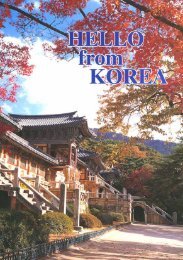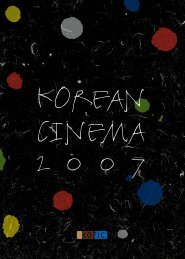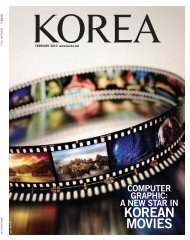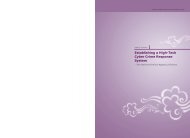My Impression of Korea - Korea.net
My Impression of Korea - Korea.net
My Impression of Korea - Korea.net
- No tags were found...
Create successful ePaper yourself
Turn your PDF publications into a flip-book with our unique Google optimized e-Paper software.
CULTURE<br />
The dog (gae)<br />
A legendary fire-eating creature, haetae<br />
dignified creature comparable to emperors<br />
and kings. Like the rulers the<br />
dragon was held accountable for protecting<br />
people and the country as well<br />
as controlling water. Hence the king’s<br />
face was called “yong-an,” the throne<br />
was “yong-sang,” the king’s virtuous<br />
mind “yong-deok,” the king’s status<br />
“yong-wi,” and his <strong>of</strong>ficial garb<br />
“yong-po.” In folk mythology the blue<br />
dragon symbolized exorcist powers,<br />
the yellow or white dragon represented<br />
the royal authority, and the fish<br />
dragon was believed to possess rainmaking<br />
powers.<br />
The rooster (dak) heralds dawn and<br />
scatters darkness, so it <strong>of</strong>ten appeared<br />
in paintings posted on middle gates.<br />
The rooster was seen to have five<br />
virtues. With its crest symbolizing a<br />
high post in civil service and sharp<br />
claws standing for military prowess, the<br />
rooster was considered valiant enough<br />
to never retreat from battle, compassionate<br />
enough to crow when it finds<br />
feed to share it with others, and credible<br />
enough to depend on for keeping time.<br />
Hence it was regarded as a virtuous<br />
fowl: the rooster, more precisely the sutak,<br />
would ensure a smooth climb up<br />
the bureaucratic ladder; the hen, or amtak,<br />
promised fertility.<br />
The phoenix(bonghwang) was a<br />
highly auspicious legendary creature<br />
<strong>of</strong>ten compared to kings (bong) and<br />
queens (hwang). One <strong>of</strong> the four<br />
guardian spirits representing the four<br />
cardinal directions, the phoenix was<br />
believed to live only atop paulownia<br />
trees, eating bamboo seeds and, once<br />
stretching its wings, it could fly 90,000<br />
li. Phoenix designs, symbolic <strong>of</strong> dignity<br />
and auspiciousness, were used for<br />
royal emblems, costumes and furniture.<br />
The <strong>Korea</strong>n presidential emblem<br />
has a phoenix design.<br />
The dog (gae) has long been a<br />
smart and faithful friend <strong>of</strong> man. From<br />
ancient times it was highly prized for<br />
its geniality and loyalty to humans and<br />
considered useful for hunting and<br />
guiding as well as guarding homes.<br />
Also, the dog was believed to be capable<br />
<strong>of</strong> protecting humans from evil<br />
spirits, disease, ghosts and wicked apparitions,<br />
as well as warning and preventing<br />
disasters. As white tigers and<br />
white horses were regarded as sacred<br />
creatures, white dogs were considered<br />
indispensable for suppressing inauspicious<br />
energies lurking around a home.<br />
Yellow dogs were <strong>of</strong>ten raised at farm<br />
houses as guardians <strong>of</strong> fertility and<br />
rich crops. The smart and handsome<br />
species native to Jin Island, Jindogae<br />
stands for courage and loyalty, and the<br />
<strong>Korea</strong>n native poodle, called sapsalgae,<br />
is believed to chase <strong>of</strong>f evil spirits.<br />
With its elegant horns stretched<br />
toward the sky, the deer (saseum) was<br />
regarded as a sacred creature capable<br />
<strong>of</strong> discerning the holy intentions <strong>of</strong><br />
heaven. Consequently, it was believed<br />
to prevent disease and invoke happiness<br />
and wealth. The deer were also<br />
envisaged as vehicles for immortals<br />
and one <strong>of</strong> the ten longevity symbols.<br />
In Chinese the two letters symbolizing<br />
the deer and public <strong>of</strong>ficials’<br />
salaries are both pronounced as lu<br />
(nok in <strong>Korea</strong>n) though they have<br />
different shapes. Hence, bailu<br />
(baengnok in <strong>Korea</strong>n), literally “one<br />
hundred deer,” came to mean “success<br />
and happiness.”<br />
The turtle (geobuk), with its round<br />
domed upper shell and flat under<br />
shell, symbolized the ancient <strong>Korea</strong>n<br />
notion <strong>of</strong> a round domed sky and a<br />
flat Earth. Thus it was regarded as a<br />
sacred creature connecting heaven<br />
and man and an emblem <strong>of</strong> longevity,<br />
felicity, stability and strength. A<br />
stone stele erected on a stone turtle<br />
back embodied hopes that it would<br />
last forever.<br />
An imaginary unicorn named<br />
girin stood for compassion and mercy.<br />
Hence its emergence was seen as a<br />
sign for the emergence <strong>of</strong> a sage king.<br />
Ancient <strong>Korea</strong>ns called a young man<br />
with prominent ability and dignity a<br />
girin-a, meaning a child prodigy.<br />
A legendary fire-eating creature,<br />
haetae, was believed to be a guardian<br />
<strong>of</strong> justice that would strike anything<br />
improper or unjust with its mighty<br />
horn. Due to its fire-eating nature,<br />
haetae symbolized water and paintings<br />
<strong>of</strong> this creature were <strong>of</strong>ten put on<br />
kitchen walls. In China a similar<br />
imaginary animal was known as<br />
xiezhi, or haechi in <strong>Korea</strong>n. ■<br />
(Photos by Suh Gong-im)<br />
(Source: Cultural Heritage<br />
Administration, <strong>Korea</strong>n Heritage)<br />
32 KOREA NOVEMBER 2008<br />
NOVEMBER 2008 KOREA 33
















